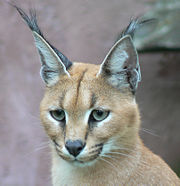Caracal
| Caracal[1] | ||||||||||||||||
|---|---|---|---|---|---|---|---|---|---|---|---|---|---|---|---|---|
 |
||||||||||||||||
| Conservation status | ||||||||||||||||
| Scientific classification | ||||||||||||||||
|
||||||||||||||||
| Binomial name | ||||||||||||||||
| Caracal caracal (Schreber, 1776) |
||||||||||||||||
| Type species | ||||||||||||||||
| Caracal melanotis Gray, 1843 (= Felis caracal Schreber, 1776) by monotypy |
||||||||||||||||
| Synonyms | ||||||||||||||||
|
Felis caracal |
The Caracal (Caracal caracal), also called Persian Lynx or African Lynx, is a fiercely territorial medium-sized cat. The Caracal takes its name from its black ears. The word Caracal comes from the Turkish word "karakulak", meaning black ears. The Caracal is labelled as a small cat, but is amongst the heaviest of all small cats, as well as the fastest.
Contents[hide] |
Description
Males typically weigh about 13-18 kg (28-40 lbs), while females are smaller. The Caracal resembles a Eurasian Lynx and for a long time it was considered a close relative of the lynxes. Recent DNA research, however, has shown that the Caracal is not a close relative of lynxes at all, but is instead related to the Serval and the African Golden Cat.[3]
The Caracal is 65 cm in length (about two ft), plus 30 cm tail (about 1 foot). It has longer legs and a slimmer appearance than a lynx. The colour of the fur is variable: it may be wine-red, grey or sand-coloured. Melanistic (black) Caracals also occur. Young Caracals bear reddish spots on the underside; adults do not have markings except for black spots above the eyes.
The most conspicuous feature of the Caracal is elongated, tufted black ears, which also explain the origin of its name – karakulak, Turkish for "black ear". Its ears, which it uses to locate prey, are controlled by 20 different muscles.
Habitat and diet

The Caracal is distributed over Africa and western Asia. Its habitat is dry steppes and semi-deserts, but also include woodlands, savanna, and scrub forest. It is a solitary, or paired, territorial cat. The Caracal may survive without drinking for a long period — the water demand is satisfied with the body fluids of its prey.
It hunts at night (but in colder seasons also in the daytime) for rodents and hares; rarely it may even attack a gazelle, a small antelope or a young ostrich. It is a picky eater, and discards the internal organs of the mammals it catches, partially plucks the fur off hyraxes and larger kills, and avoids eating hair by shearing meat neatly from the skin. However, it will eat the feathers of small birds and is tolerant of rotten meat.
It is most well-known for its skill with hunting birds; the Caracal is able to snatch a bird in flight, sometimes more than one at a time. The Caracal can jump and climb exceptionally well, which enables it to catch hyraxes better than probably any other carnivore. Its life expectancy in the wild is 12 years, or 17 years in captivity. Since it is also surprisingly easy to tame, it has been used as a hunting cat in Iran and India.
Conservation

Because it is so easily tamed, the Caracal is sometimes kept as a pet, and is said to adapt easily to living with humans. It is often viewed as vermin by farmers in Africa because it frequently climbs over fences to eat chickens and other poultry.
The Caracal is almost impossible to see in the wild, not because there are very few of them, but because it hides extremely well. Game drives in countries such as Kenya and Botswana widely encounter other animals, but a sighting of a Caracal is extremely rare.
The Caracal has been hybridised with the domestic cat at the Moscow Zoo.[4]
Subspecies
- Caracal caracal caracal, East, Central and South Africa
- Caracal caracal algira, North Africa
- Caracal caracal damarensis, Namibia
- Caracal caracal limpopoensis, Botswana
- Caracal caracal lucani, Gabon
- Caracal caracal michaelis, Turkmenistan (endangered)
- Caracal caracal nubica, Ethiopia, Sudan
- Caracal caracal poecilotis, West Africa
- Caracal caracal schmitzi, Israel, West Asia, Iran, Arabia, Pakistan, India
References
- ↑ Wozencraft, W. C. (16 November 2005). Wilson, D. E., and Reeder, D. M. (eds). ed.. Mammal Species of the World (3rd edition ed.). Johns Hopkins University Press. pp. 533. ISBN 0-801-88221-4. http://www.bucknell.edu/msw3.
- ↑ Cat Specialist Group (2002). Caracal caracal. 2006 IUCN Red List of Threatened Species. IUCN 2006. Retrieved on 12 May 2006. Database entry includes justification for why this species is of least concern
- ↑ http://www.botany.wisc.edu/courses/botany_940/papers/Johnson&2005.pdf
- ↑ Kusminych, I, and Pawlowa, A (1998). "Ein Bastard von Karakal Hauskatze im Moskauer Zoo". Der Zoologische Garten 68 (4).
External links
- Video of a caracal catching a bird in Tanzania's Serengeti
- Story of an abandoned caracal kitten raised by humans in Kenya
|
||